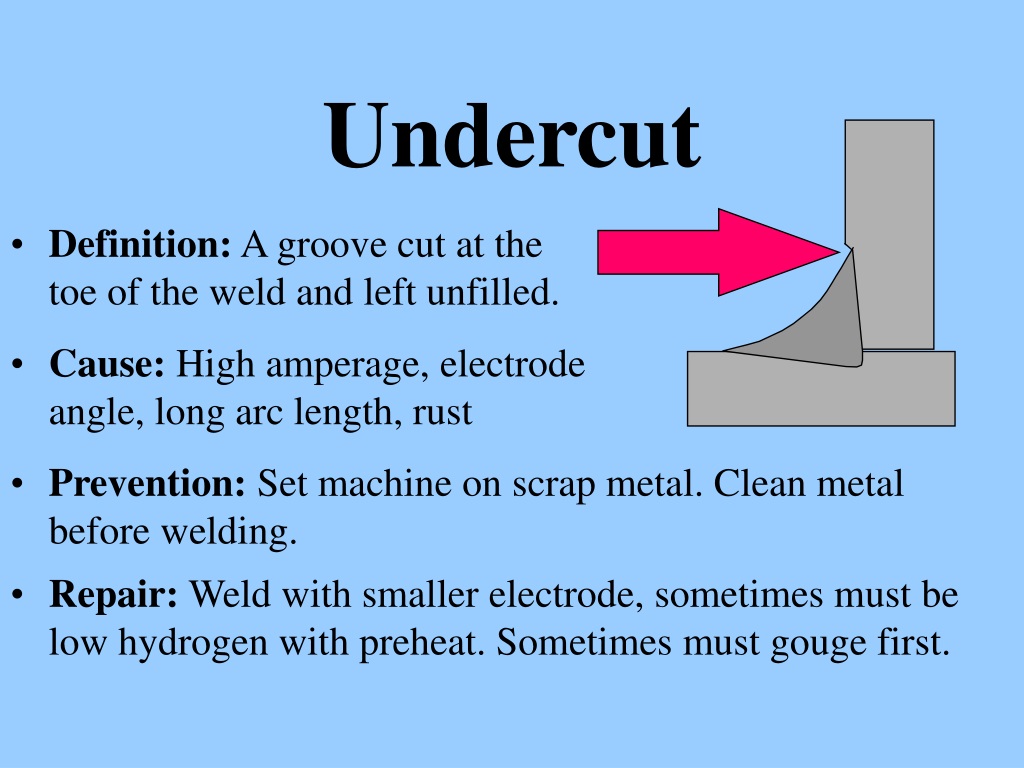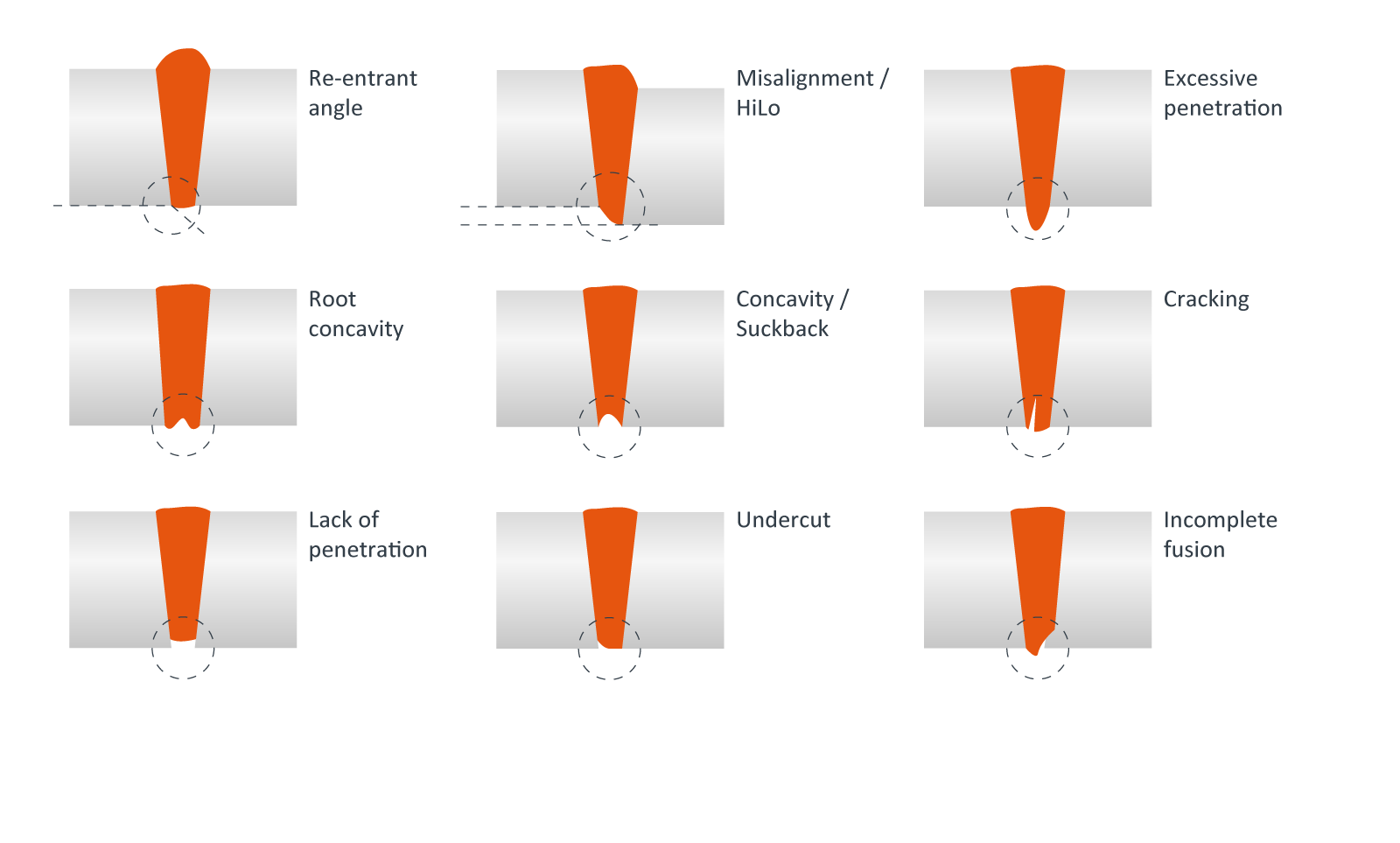Expert Methods for Preventing Weld Undercut Properly
Expert Methods for Preventing Weld Undercut Properly
Blog Article
Comprehending the Causes and Solutions for Undercut Welding in Steel Manufacture Procedures
In the world of steel manufacture procedures, the occurrence of undercut welding poses a considerable difficulty that demands a detailed understanding of its reasons and feasible options. The detailed interaction of numerous aspects throughout welding procedures can cause this unfavorable sensation, affecting the structural stability and overall quality of the welded joints - Preventing weld undercut. By dissecting the source of undercut welding and discovering reliable restorative steps, producers can raise the standard of their workmanship and ensure the manufacturing of remarkable metal components
Common Root Causes Of Undercut Welding
Regularly forgotten in steel construction, undercut welding occurs due to numerous aspects that demand meticulous focus and knowledge to be effectively mitigated. One usual root cause of undercut welding is extreme warm input. When the heat input is expensive, it can bring about the melting and subsequent erosion of the base material along the sides of the weld joint, producing a groove or undercut. Additionally, inappropriate welding methods, such as using the incorrect welding angle or travel rate, can likewise add to damage formation. Poor protecting gas coverage is an additional crucial factor that can cause undercutting. Not enough gas protection fails to shield the weld pool adequately, bring about oxidation and undercut problems. Moreover, the option of welding parameters, such as voltage, present, and cord feed speed, plays a significant function in the event of undercut welding. Understanding these typical reasons is crucial for carrying out preventive steps and ensuring premium welds in metal construction procedures.
Impact of Incorrect Welding Parameters
Incorrect welding criteria can significantly jeopardize the honesty and quality of bonded joints in steel manufacture processes. The effect of wrong welding parameters materializes in numerous ways, leading to structural weaknesses and defects in the bonded parts. Meticulous attention to welding specifications is extremely important to ensure the production of high-grade welds with the desired mechanical buildings and architectural integrity.
Effect of Improper Torch Angle
Incorrect lantern angle in welding procedures can significantly affect the quality and honesty of the last weld joints in steel construction processes. Damaging is a typical welding issue where a groove creates along the weld toe, compromising the joint and jeopardizing its architectural integrity.
A lantern angle that is also steep can cause inadequate penetration, insufficient fusion, and boosted spatter. On the other hand, a lantern angle that is as well superficial can result in excessive penetration, burn-through, and distortion of the base product. Preventing weld undercut. Appropriate torch angle is crucial for making sure consistent weld top quality, toughness, and appearance
To stop undercutting and various other problems created by improper torch angles, welders should be educated to preserve the right lantern angle throughout the welding process. Regular tracking and adjustment of lantern angles throughout welding can aid attain audio welds with very little issues.
Duty of Inadequate Welding Techniques

An additional facet of inadequate welding techniques is inappropriate weld prep work. Inadequate cleaning of the base metals, inaccurate joint design, or not enough edge prep work can all add to damage welding. Insufficient shielding gas protection or using the wrong type Clicking Here of gas can result in insufficient combination and the development of undercut defects.
To address the duty of poor welding methods in metal fabrication procedures, it is important to give detailed training for welders. Appropriate education on welding criteria, joint prep work, and shielding gas option can aid avoid undercut welding and ensure high-quality welds in steel construction projects.
Reliable Solutions for Undercut Welding
Dealing with undercut welding in metal manufacture requires applying efficient solutions to boost weld high quality and architectural stability. Among the main solutions to battle undercut is to adjust welding try these out criteria such as voltage, present, and take a trip rate to guarantee correct heat input and blend. By fine-tuning these settings, welders can protect against excessive melting of the base steel and filler material, minimizing the likelihood of undercut development.
Additionally, appropriate joint prep work is important in protecting against undercut. Guaranteeing tidy base metal surfaces cost-free of contaminants and making use of the appropriate bevel angle can assist advertise better weld penetration and minimize the risk of undercut - Preventing weld undercut. Employing appropriate welding strategies, such as weaving or oscillating the torch, can additionally aid in distributing warm equally and filling the weld joint effectively, minimizing the possibility of undercut flaws
In addition, picking the correct welding consumables, including electrodes and filler metals, is crucial in mitigating undercut. Utilizing materials with proper chemical make-ups and mechanical residential properties can add to attaining audio welds with minimal undercut. Regular evaluation and quality assurance procedures must additionally be applied to identify and address undercut issues their website promptly, guaranteeing the overall integrity of fabricated metal parts.

Conclusion
In conclusion, recognizing the reasons and remedies for undercut welding in steel manufacture procedures is vital for attaining top notch welds. By attending to typical causes such as incorrect welding parameters, inappropriate lantern angle, and insufficient welding methods, welders can avoid undercutting and ensure solid, long lasting welds. It is necessary to focus on these elements and implement reliable remedies to enhance the general welding process and end product high quality.

Report this page